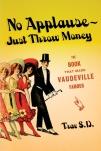One of the points I make in No Applause is that vaudeville THE FORM didn’t die (at least in the 1930s), it just switched the medium of delivery. In other words, though people stopped going to the theatre, they still got plenty of vaudeville in their own living rooms through radio and television. This is certainly the means through which this correspondent fell in love with it in the 1970s.
On NBC’s maiden broadcast on November 14, 1926, listeners heard Will Rogers, Weber and Fields, Eddie Cantor, the Ben Bernie Orchestra and opera singer Mary Garden. Day in, day out, from here on in this was business as usual, with scores of vaudeville performers being booked to fill the air time. The following year, CBS was launched, increasing the demand for radio talent yet again. Audiences for the new product grew exponentially. 3 million houses already had radios in 1927. By the end of the 1930’s, the number had grown ten fold.
In the 30s, vaudeville stars like Cantor, Burns and Allen, Fred Allen, Jack Benny, Ed Wynn, Fanny Brice, and all of the big band leaders of the day, became major radio stars. To enjoy them, you didn’t have to take your bathrobe off. You didn’t even have to get out of bed. Going to a vaudeville theatre to see stars is kind of illogical when all the vaudevillians are coming to you live through your own furniture.
Of course, as a sound-only medium, the dynamic was somewhat different. There’s that old joke — a true story — about tap dancing on radio. Clearly such acts as dancers, acrobats, mimes and animal acts made little sense on radio. Oddly, the ventriloquist Edgar Bergen became one of its greatest stars, even though you couldn’t see his dummies (or his lips). So radio became mostly a haven for comedians, actors, singers and musicians.
Then, a few years later, technology changed the game again, with a device that addressed the problem of the missing picture.
In 1947, Variety ran an ad which proclaiming “Vaudeville is Back! The Golden Era of Variety begins with the Premiere of Texaco Star Theatre on Television”. Milton Berle’s hit program was joined that year by Ed Sullivan’s Toast of the Town, the next year by The Admiral Broadway Revue starring Sid Caesar, and Cavalcade of Stars, featuring first Jack Carter, then Jackie Gleason. 1950 saw the debut of The Ken Murray Show; The Colgate Comedy Hour (with guest hosts such as Eddie Cantor, Bob Hope and Jimmy Durante); and The Four Star Revue (with Durante, Wynn, Danny Thomas, and Jack Carson as alternating hosts). The Red Skelton Show launched in 1951, the critically-acclaimed Red Buttons Show in 1952. The Tonight Show, starring Steve Allen, the son of two vaudevillians, began in 1954. In 1964, a variety show called The Hollywood Palace, specifically modeled on its Times Square namesake, debuted on ABC, and held its own in the ratings until it went off in 1970.
Some of the performances I saw on old Ed Sullivan shows on a recent trip to the Museum of Television and Radio (now called the Paley Center) in New York: comedy duo Wayne and Shuster; ukulele freak Tiny Tim; a star-studded Irving Berlin tribute; Maurice Chevalier; Sophie Tucker; Carl Sandburg reading poems; a Russian dance troupe; stars of the Metropolitan Opera (featuring Joan Sutherland); Bert Lahr; Smith and Dale; ballet dancers; plate spinners; fire eaters; teeterboard tumblers; trick cyclists; trampoline artists; trained elephants, tigers, dogs; a Van Kliburn piano recital; Judy Garland singing Chaplin’s song “Smile”. When the Ed Sullivan show went off the air in 1972, vaudeville was said to have died its second death. But, we all know even that ain’t so, don’t we, readers?
To learn more about variety shows on radio and television, consult No Applause, Just Throw Money: The Book That Made Vaudeville Famous, available at Amazon, Barnes and Noble, and wherever nutty books are sold.


![ed_sullivan[1]](https://travsd.files.wordpress.com/2011/08/ed_sullivan1.jpg?w=300&h=203)